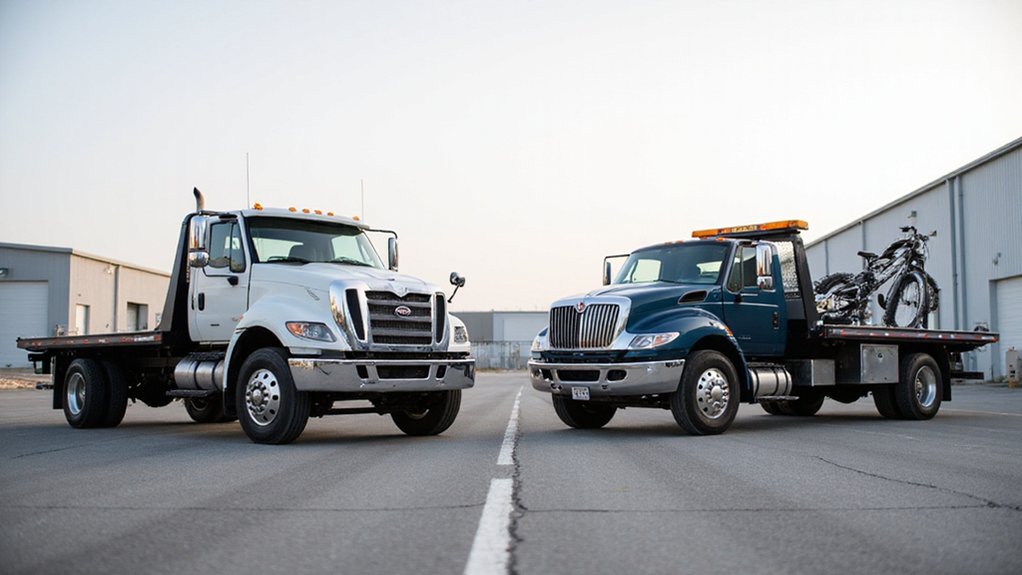When you're facing a tow, you'll want to choose between flatbed and wheel-lift methods. Flatbed towing completely lifts your vehicle, offering superior protection for luxury or damaged cars. Wheel-lift towing is faster and more budget-friendly, ideal for standard vehicles. Your choice depends on your car's condition, value, and transportation needs. Want to guarantee your vehicle arrives safely? The details ahead will help you make the best decision.
What Is Flatbed Towing?
Have you ever wondered how heavy or delicate vehicles get transported without additional damage? Flatbed towing provides a safe, secure method for moving vehicles that safeguards minimal risk during transportation.
When a flatbed truck arrives, your entire vehicle is loaded onto a flat, elevated platform, which completely lifts the car off the ground. This approach prevents wear and tear on your vehicle's wheels and transmission.
Whether you've got a luxury sports car, a vintage collector's vehicle, or a damaged automobile, flatbed towing offers superior protection compared to traditional towing methods. Long-distance towing services in Cleveland utilize flatbed trucks to transport a wide range of vehicles safely across multiple states.
What Is Wheel-Lift Towing?
Why do some towing services use a different approach for vehicle transportation? Wheel-lift towing offers a practical alternative to flatbed methods, utilizing a metal yoke that hooks under your vehicle's wheels. This technique lifts either the front or rear wheels off the ground while the other set remains on the road. It's typically faster and more cost-effective than flatbed towing, making it appealing for shorter distances or less delicate vehicles. In the Cleveland, Ohio region, motorcycle owners can benefit from these versatile towing techniques when facing unexpected roadside challenges.
You'll find wheel-lift towing works well for standard cars, sedans, and many SUVs, providing a reliable transportation solution when you're facing unexpected vehicle challenges.
Advantages of Flatbed Towing
Since safety and vehicle protection are paramount in towing, flatbed towing emerges as the gold standard for transporting delicate or high-value vehicles. You'll appreciate how this method completely lifts your entire vehicle off the ground, eliminating potential damage to wheels and undercarriage during transport.
Flatbed towing provides superior security, ensuring your car remains stationary and protected from road debris and unexpected bumps. Whether you've got a classic car, luxury sedan, or all-wheel-drive vehicle, a flatbed truck offers the most reliable and safest transportation option, giving you peace of mind throughout the towing process.
Advantages of Wheel-Lift Towing
While flatbed towing sets a high standard for vehicle protection, wheel-lift towing offers its own set of persuasive advantages that make it an attractive option for many drivers. You'll appreciate its cost-effectiveness and versatility, especially when dealing with tight spaces or budget constraints.
Wheel-lift towing can quickly hook up your vehicle, using less equipment and requiring minimal setup time. It's particularly efficient for smaller cars and vehicles with front-wheel drive. Your tow truck operator can maneuver more easily, reducing potential complications during the towing process.
When to Choose Flatbed Towing
Are you wondering when flatbed towing becomes the ideal solution for your vehicle? Certain situations demand the superior protection and versatility of flatbed towing. Consider these critical scenarios:
- High-end luxury or sports cars with low ground clearance
- Vehicles with significant structural damage or wheel problems
- Classic or vintage automobiles requiring maximum preservation
- All-wheel and four-wheel drive vehicles needing complete wheel elevation
Flatbed towing guarantees your precious vehicle remains secure and undamaged during transportation. When standard towing methods might risk further complications, a flatbed truck provides the safest, most dependable solution for transporting your precious automotive investment.
When to Choose Wheel-Lift Towing
In the world of vehicle towing, wheel-lift towing emerges as a practical and cost-effective solution for many everyday transportation needs. When your vehicle requires a quick, affordable tow and isn't severely damaged, wheel-lift might be your best option. It's typically faster and less expensive than flatbed towing, making it ideal for short-distance transportation.
You'll appreciate its efficiency when dealing with standard cars and trucks in good condition. Wheel-lift towing works well for vehicles with functioning suspensions and no significant structural damage, providing a reliable and budget-friendly solution for most roadside emergencies.
Frequently Asked Questions
How Much Does Each Towing Method Typically Cost?
You'll typically pay $75-$125 for a local wheel-lift tow, while flatbed services range from $95-$175, depending on distance, vehicle weight, and your location's towing market rates.
Can I Request a Specific Towing Method From a Service?
Yes, you can request a specific towing method from most services. They'll often accommodate your preference, especially if you explain your vehicle's condition or special requirements.
What Happens if My Car Gets Damaged During Towing?
If your car's damaged during towing, you'll want to document everything immediately. Contact the towing company, take photos, and file an insurance claim to guarantee you're covered for any repairs.
Do Insurance Companies Prefer One Towing Method Over Another?
Insurance companies often prefer wheel-lift towing for minor damages, as it's cost-effective. You'll find they typically recommend this method when your vehicle can be safely transported without additional risk.
How Long Does Each Towing Method Take to Complete?
You'll find wheel-lift towing typically takes 10-15 minutes, while flatbed towing can range from 15-30 minutes depending on vehicle condition and loading complexity.



